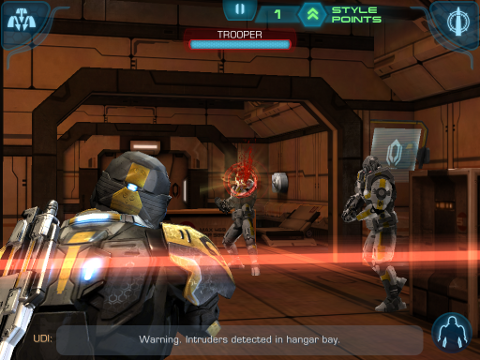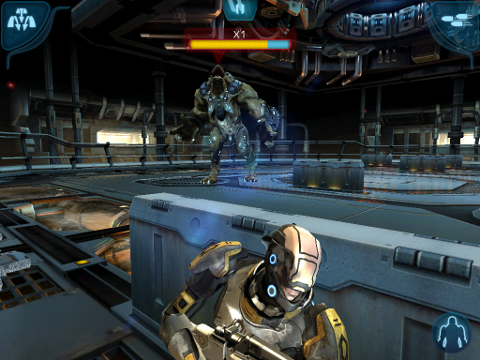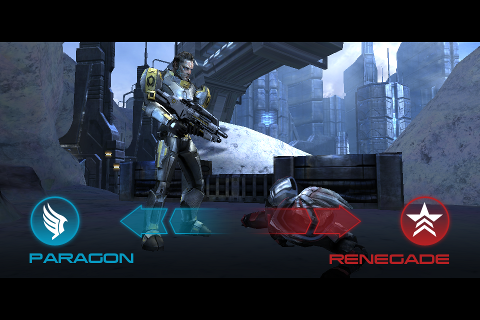Mass Effect can’t catch a break on iOS. EA’s first attempt to bring the massive space RPG to handhelds, Mass Effect Galaxy, was such a disaster that the publisher actually pulled it from the App Store. But as the saying goes, first is the worst, and second is the best. With IronMonkey Studios (the developers of Dead Space on iOS) behind it, Mass Effect Infiltrator must be awesome, right?
Wrong. Very, very wrong.
Mass Effect Infiltrator has major problems across its storyline, gameplay, and production values. The Mass Effect console series invests you deeply in its story and lore, but Infiltrator has neither of these things. When it comes to lore, expect to see little more than a sprinkling of races and style cues from this game’s console counterparts. As for the story, it’s almost non-existent.
You play as Randall Ezno, a Cerberus operative who goes all-out homicidal on the pro-human organization when he learns of their sinister plans. He goes to rescue his friend, Inari, with the help of a Volus. You will find nothing in this game that connects it to the main series beyond the Illusive Man being meaninglessly name-dropped a few times.
The story is told through the occasional line of dialogue between fights, which never amount to more than “Keep moving forward,” “You will never stop us,” and “Kill the enemies!” The plot never reaches its conclusion, and without a “to be continued” screen, we can only assume that the ending was cut due to time constraints. You probably won’t care about what little story there is.
Character conversations and exploration of any sort are missing from Infiltrator as well. What you get are corridors with a battle around every corner. You’ll be inside the sterile Cerberus base for almost the entirety of the game, and just as the environment never changes, neither do the enemies. You’ll be fighting the same types of baddies from start to finish, though they are of different alien races. The two boss fights in the game aren’t very interesting, requiring you to run, shoot, find cover, and repeat.
The combat is a problem in itself. Instead of taking the logical route of making this game a traditional third-person shooter, the developers opted for a touch system where you tap on selectable enemies to bring up a reticule, and then aim it at their designated weak spot, which is always the head. Besides being far less engaging than an actual third-person shooter, there are some fundamental problems with these mechanics.

Different weapons have varying ranges in which enemies can be selected. For example, the shotgun does big damage up close, the assault rifle has medium range, and the sniper rifle can take out enemies from afar. However, your assault rifle can’t fire mere inches outside of the designated range. Plus, you can only target and shoot at enemies precisely within your line of sight. This system requires you to move your position entirely just to get a shot off.
Your weapons are actually pretty weak, so the real brawn comes with your set of biotic abilities. For those not familiar with the Mass Effect series, think of these as a take on Force powers from Star Wars. Only two of the four available powers have any use. First is Pull, which lifts enemies into the air, pulls them towards you for a period of time, and weakens their defenses. The second is the Leash, which strangles an enemy and throws them in a direction of your choosing, effectively killing them.
As great as these moves are, you’ll often find yourself waiting for them to cool down while crouching behind the cover. Dumb AI that often remains stationary behind the cover makes this tactic possible. Any enemies that do come near you can be taken care of with a few shotgun blasts. Also, using a Leash disrupts the game’s flow, because your character becomes impervious to damage while undergoing this fairly long and involved action. It takes around six seconds to complete the Leash move, which gets old quickly.
Other tricks you can use in combat include melee attacks, temporary cloaking, and sprinting, but it all boils down to a series of taps and swipes that don’t resemble Mass Effect’s thrilling firefights in the least.

The controls aren’t any better. You control Randall’s movements by sliding your finger on the left side of the screen to run and using the right side of the screen to adjust the camera. When you’re near an object that can provide cover, you can swipe up on the screen to crouch behind it. Flicking left and right when on either side of the cover causes Randall to sprint behind the next closest cover, while flicking up will result in Randall vaulting over crates and barriers. All of this feels clunky due to a choppy frame rate and low sensitivity. We can’t count the number of times that Randall accidentally leaped over a crate and right into enemy fire, taking only a few hits before dying. Most of our deaths were due to unnecessary control misfires.
After each combat encounter, you’re given ratings based on time, health, and style. You can build up your style rating by taking down different enemies with varying tactics, a worthwhile attempt at encouraging the player to use all of the skills at their disposal. While this means you’re not always using your best skills, it’s important to score well in all three categories in order to rack up credits for use in the in-game store.
Every aspect of your character, including weapons, armor, biotics, and abilities, is purchased and upgraded using credits. It’s not as interesting as allocating skills points after leveling your character in the main series, but it works for this game. The big downside is that the best equipment, abilities, and upgrades come at a steep price. It will take you at least one New Game+ playthrough to purchase most of what’s available. Of course, you’re encouraged to spend real money on in-game credits, which is a poor proposition for a premium single-player game.
Some enemies also drop intel when killed in combat. These serve two purposes: You can either sell them for extra credits or upload them to Mass Effect 3, improving your “galactic readiness” in that game. Your galactic readiness level allows you to unlock the best ending in the console game if you max it out. However, you can still get the best ending in Mass Effect 3 without playing Infiltrator.

At a few junctures, Mass Effect’s iconic paragon/renegade system is also brought into play. However, the choice always boils down to “kill a random person” or “let the random person go,” with no context as to why the person should live or die other than their affiliation with Cerberus. Your choice has no effect on the game, either, which is the entire point of the paragon/renegade mechanic. In other words, it’s both tacked on and tacky.
Visually, much of Mass Effect Infiltrator looks detailed and highly impressive, but graphics aren’t everything. Even though the visuals look great in screenshots, they can feel repetitive and boring as you play. Texture quality is inconsistent, with some objects in the environment appearing at a lower resolution than everything else. It seems to us that some corners were cut in order to release this iOS game with the launch of Mass Effect 3 on consoles.
The Mass Effect series has been highly regarded for its superior voice acting. While we didn’t expect the voice acting for Infiltrator to equal that of the main series, there is a standard to keep up. What you’ll hear is some of the worst voice acting in an iOS game to date. It’s so bad that you’ll laugh, cringe, and cry all at the same time. It doesn’t help that the script is terrible, and repeated over and over again.
The soundtrack is pulled mostly from the main series, with one notable, hilarious exception: the elevator music that plays in the store menu. We can hardly bring ourselves to fault the developers for this inclusion, as it’s so out-of-place and ridiculous in a game that takes itself so very seriously.
We had high hopes for Mass Effect Infiltrator. The graphics are clearly outstanding, but the gameplay and control issues ruin the fun. This ambitious project is just as disappointing as Mass Effect Galaxy. Even if you’re the most die-hard of the die-hard Mass Effect fans, this painful-to-play shooter is not worth your time.